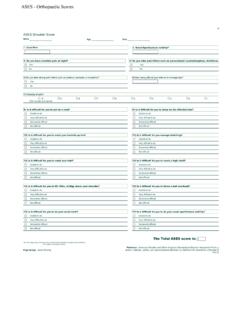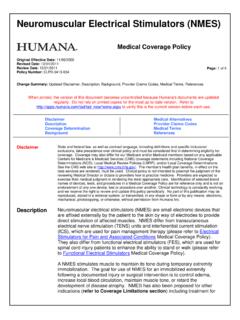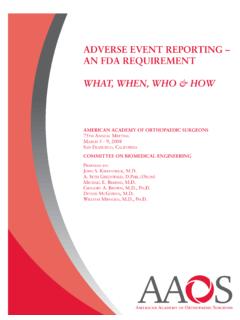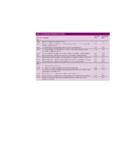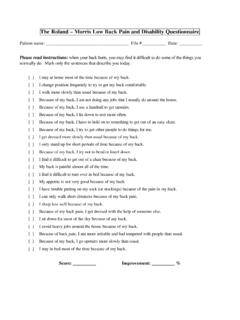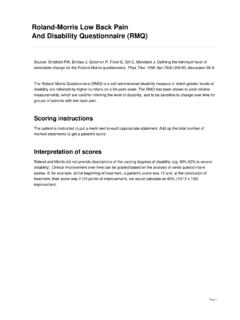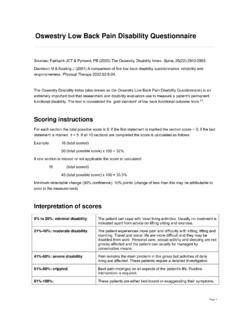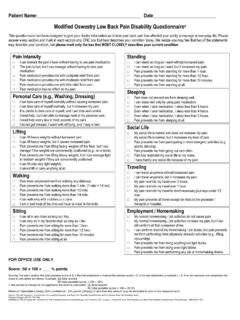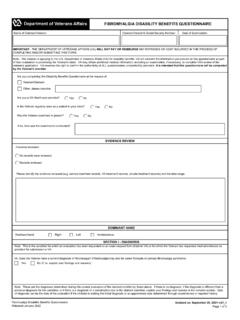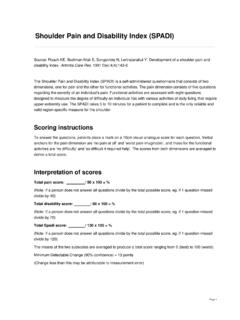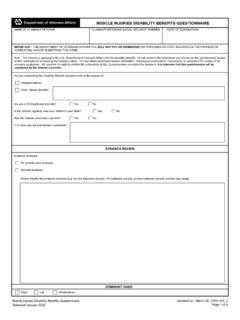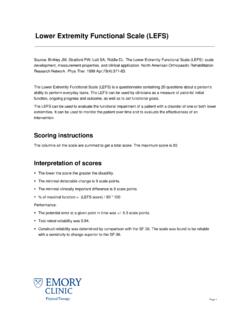Transcription of OSWESTRY LOW BACK DISABILITY QUESTIONNAIRE
1 1. pain INTENSITY I can tolerate the pain I have without having to use pain killers The pain is bad but I manage without taking pain killers pain killers give complete relief from pain pain killers give moderate relief from pain pain killers give very little relief from pain pain killers have no effect on the pain and I do not use them 6. STANDING I can stand as long as I want without extra pain I can stand as long as I want but it gives me extra pain pain prevents me from standing for more than one hour pain prevents me from standing for more than 30 minutes pain prevents me from standing for more than 10 minutes pain prevents me from standing at all 2. PERSONAL CARE ( Washing, Dressing) I can look after myself normally without causing extra pain I can look after myself normally but it causes extra pain It is painful to look after myself and I am slow and careful I need some help but manage most of my personal care I need help every day in most aspects of self care I don t get dressed, I was with difficulty and stay in bed 7.
2 SLEEPING pain does not prevent me from sleeping well I can sleep well only by using medication Even when I take medication, I have less than 6 hrs sleep Even when I take medication, I have less than 4 hrs sleep Even when I take medication, I have less than 2 hrs sleep pain prevents me from sleeping at all 3. LIFTING I can lift heavy weights without extra pain I can lift heavy weights but it gives extra pain pain prevents me from lifting heavy weights off the floor, but I can manage if they are conveniently positioned, on a table pain prevents me from lifting heavy weights, but I can manage light to medium weights if they are conveniently positioned I can lift very light weights I cannot lift or carry anything at all 8. SOCIAL LIFE My social life is normal and gives me no extra pain My social life is normal but increases the degree of pain pain has no significant effect on my social life apart from limiting my more energetic interests, dancing, etc.
3 pain has restricted my social life and I do not go out as often pain has restricted my social life to my home I have no social life because of pain 4. WALKING pain does not prevent me walking any distance pain prevents me walking more than one mile pain prevents me walking more than mile pain prevents me walking more than mile I can only walk using a stick or crutches I am in bed most of the time and have to crawl to the toilet 9. TRAVELLING I can travel anywhere without extra pain I can travel anywhere but it gives me extra pain pain is bad, but I manage journeys over 2 hours pain restricts me to journeys of less than 1 hour pain restricts me to short necessary journeys under 30 minutes pain prevents me from traveling except to the doctor or hospital 5. SITTING I can sit in any chair as long as I like I can only sit in my favorite chair as long as I like pain prevents me from sitting more than one hour pain prevents me from sitting more than hour pain prevents me from sitting more than 10 minutes pain prevents me from sitting at all 10.
4 EMPLOYMENT/ HOMEMAKING My normal homemaking/ job activities do not cause pain . My normal homemaking/ job activities increase my pain , but I can still perform all that is required of me. I can perform most of my homemaking/ job duties, but pain prevents me from performing more physically stressful activities ( lifting, vacuuming) pain prevents me from doing anything but light duties. pain prevents me from doing even light duties. pain prevents me from performing any job or homemaking chores. Instructions: this QUESTIONNAIRE has been designed to give us information as to how your back pain has affected your ability to manage everyday life. Please answer every section and mark in each section only the ONE box which applies to you at this time. We realize you may consider 2 of the statements in any section may relate to you, but please mark the box which most closely describes your current condition.
5 OSWESTRY LOW back DISABILITY QUESTIONNAIRE Scoring the OSWESTRY DISABILITY IndexNo disabilityThe patient can cope with most living activities. Usually no treatment is indicated apart from advice on lifting, sitting and disabilityThe patient experiences more pain and difficulty with sitting, lifting and standing. Travel and social life are more difficult and they may be disabled from work. Personal care, sexual activity and sleeping are not grossly affected and the patient can usually be managed by conservative disabilityPain remains the main problem in this group but activities of daily living are affected. These patients require a detailed disabilityBack pain impinges on all aspects of the patient s life. Positive intervention is disabledThese patients are either bed-bound or are exaggerating their BOTHER WITH AN OUTCOMES MEASURE? As physical therapy works towards autonomous practice and incorporating evidence-based medicine into it s practice, it is imperative that therapists utilize measuring tools which have been validated through companies and physicians are very familiar with these instruments and are asking for scores such as : Fairbank JC, Pynsent PB.
6 The OSWESTRY DISABILITY Index. Spine 2000: 25(22):2940-2952 Fairbank JCT, Couper J, Davies JB. The OSWESTRY Low back pain QUESTIONNAIRE . Physiotherapy 1980; 66 : For each question, there is a possible 5 points; 0 for the first answer, 1 for the second answer, etc. Add up the total for the 10 questions and rate them on the scale at DISABILITY LEVEL 0 - 4 No DISABILITY 5 - 14 Mild DISABILITY 15 - 24 Moderate DISABILITY 25 - 34 Severe DISABILITY 35 - 50 Completely disabledThe OSWESTRY DISABILITY Index (aka the OSWESTRY Low back pain DISABILITY QUESTIONNAIRE ) is an ex-tremely important tool that researchers and DISABILITY evaluators use to measure a patient s permanent functional DISABILITY . The test has been around since 1980 and is considered the gold standard of low back pain functional outcome tools.
